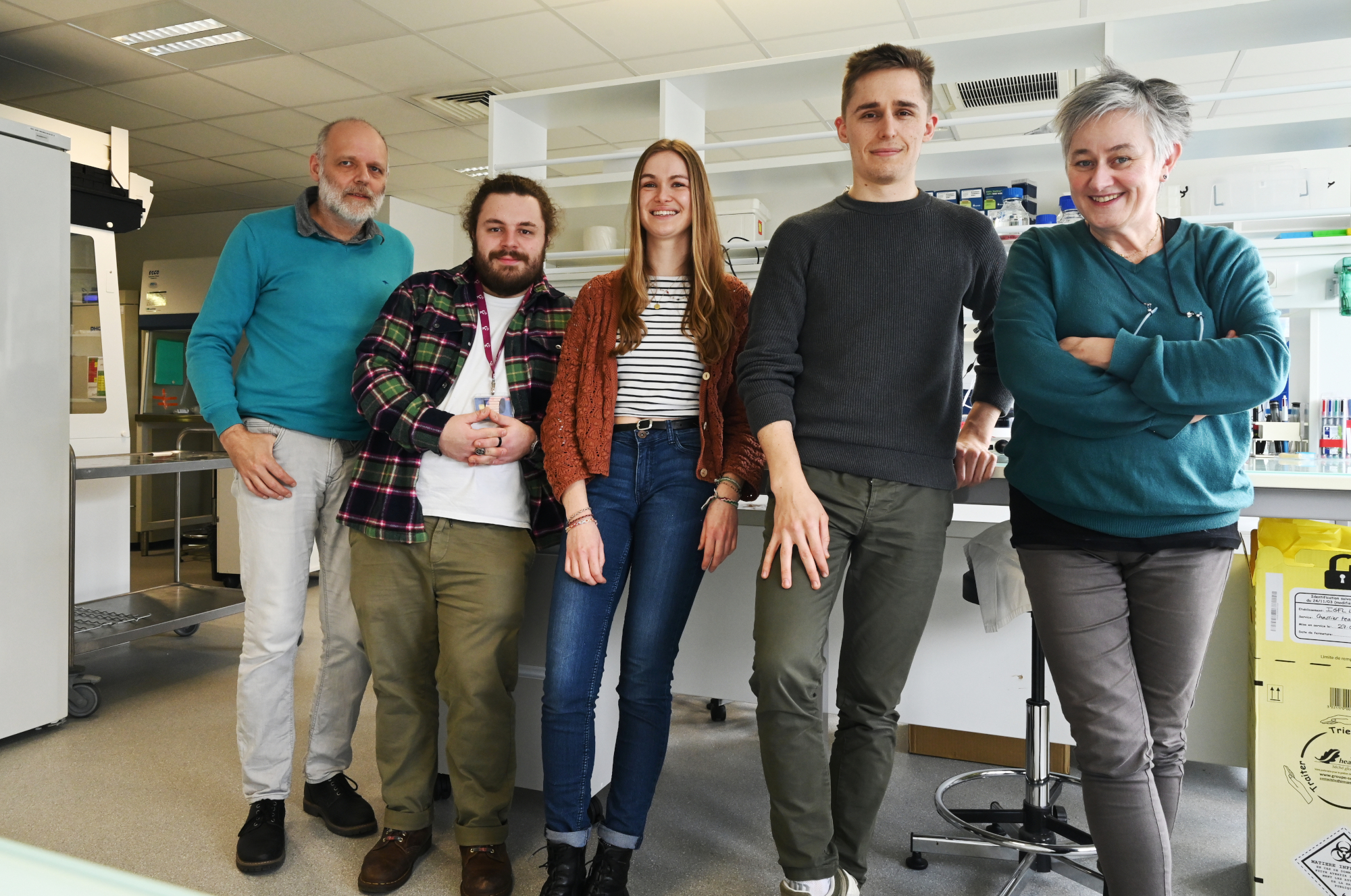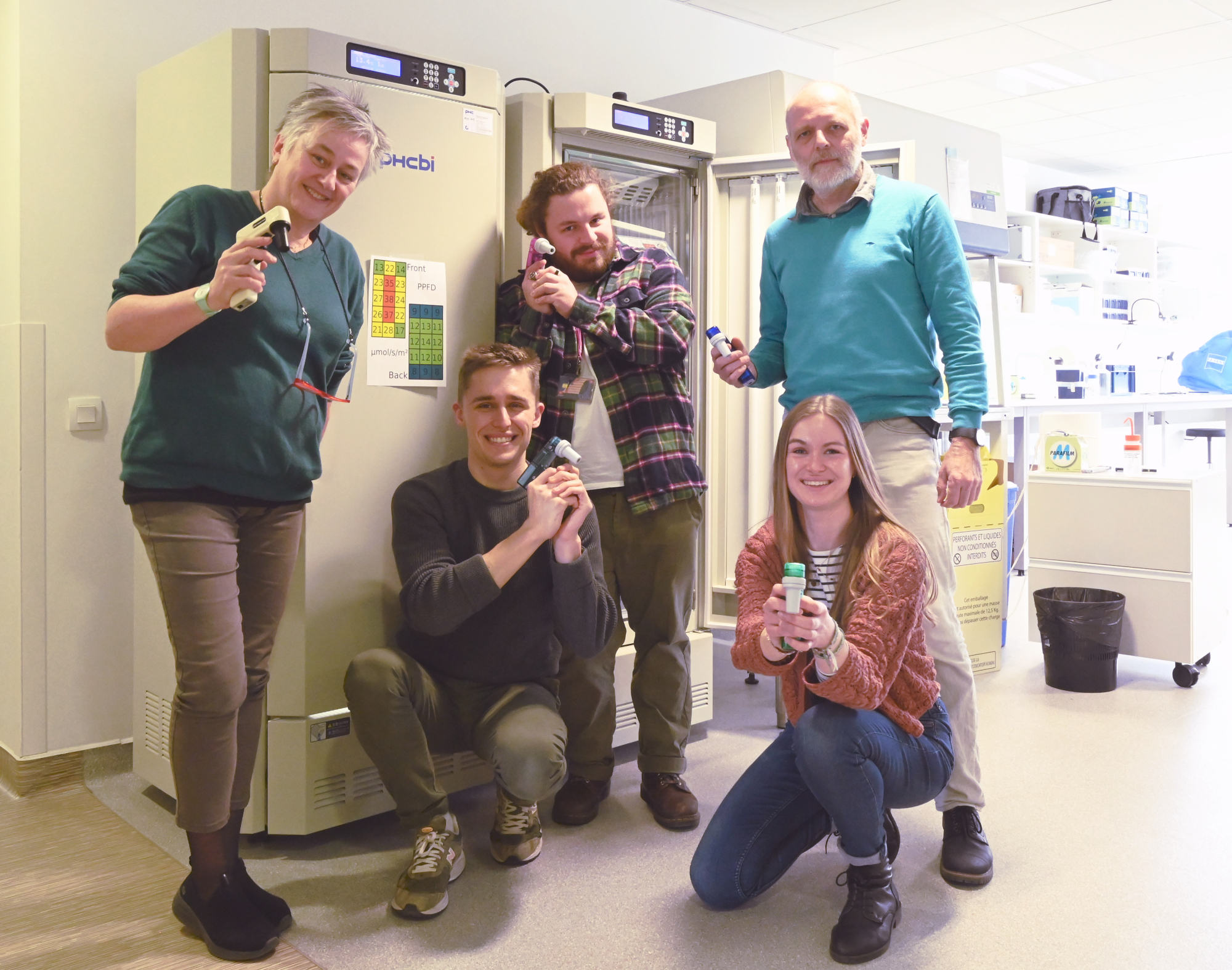Lab meeting with the Charrier lab
Posted by the Node, on 11 April 2024
Where is the lab?
The lab is located in the southern part of the city of Lyon, France on the campus of the Ecole normale supérieure (ENS). It is one of the CNRS research groups at the Institute of Functional Genomics of Lyon (IGFL), which focuses on integrating developmental, physiological and evolutionary perspectives to study complex biological systems at the organism level.
Research summary
Our group studies the morphogenesis of brown algae. These organisms, some of which can grow to 45 m long, have evolved independently of plants and animals. We work on identifying the strategies that these organisms have adopted to establish their body plans at the embryogenesis stage. In particular, right now we are exploring which mechanisms control the position and the orientation of cell division planes. When, where and how do cells grow and divide is our current obsession!
This question is even more challenging when applied to our favourite models: brown algae are largely understudied multicellular organisms that possess unique cellular components – in terms of cell wall composition, vesicular and cytoskeleton organisation, pigments – resulting from their distinctive evolutionary pathway.

Lab roll call
Marie Zilliox: I’m a post-doc with a PhD in zebrafish development, and my mission is to monitor the growth of brown algal embryos in real time and in 3D using light-sheet and multi-photon microscopy techniques to determine whether cell shape controls the orientation of cell division. The challenge lies in mastering long-term time-lapse microscopy in 3D and in culture conditions compatible with the natural environment as well as with the presence of pigments that diffract light.
Tanguy Dufourt: I’m a first-year PhD student. I hold a Master’s degree in Systematic Evolution and Paleontology (MNHN Paris), and I am now studying which intracellular mechanisms are involved in the orientation of cell divisions in brown algal cells. I aim to model the displacement of centrosomes during the cell cycle by using software based on the forces generated by and applied to dynamic microtubules. First, I need to adapt this software to the cell biology of brown algae: cuboid cell shapes, presence of chloroplasts and vacuoles, throughout the cytoplasm, etc.
Alexis Martel: I have a Master’s in Marine Biology (Toulon University, France), more specifically in biotic interactions and anthropogenic disturbances in marine environments. I work here as a lab manager. In the past 6 months, I have set up most of the lab equipment and the cultures of the brown algal models of the team at IGFL. Now I am developing new microfluidics protocols for the forthcoming team projects involving this technique.
Bernard Billoud: I am a lecturer with a 30-year university career in bio-informatics, and a researcher working on modelling and simulation of algal development. My role is to develop mathematical and mechanical models that can account for the tissue patterning in brown algae. As a member of a team where most of the members are involved in experimental work on the bench, I can assess the time and technicality required to obtain the quantitative data on living organisms that I need to validate the models.
Bénédicte Charrier: I am the leader of the team. As a former land plant biologist, I have been studying the development of brown algae for the past 20 years. I come from a molecular and genetic background, and I am now studying the role of mechanical forces in the process of morphogenesis. Interdisciplinarity combining cell biology with mathematics and physics is what I need to answer my questions.
Favourite technique, and why?
Bénédicte: I love penetrating the microscopic world! Beyond observing live or fixed, labelled or even unlabelled cells, I am now captivated by microinjection. It provides me with an “intimate” moment spent with the algae. Microinjection requires lengthy preparation, but when the time has come for the needle to touch the cell surface, then the conversation starts. And in this specific context, different cells of brown algae reveal their lot of unexpected responses!
Apart from your own research, what are you most excited about in developmental and stem cell biology?
Bénédicte: I’d like to understand the complexity of biological systems. How do cells co-ordinate themselves or work together to form an organism? How do the different molecules that make up a cell interact to produce a functional living cell? What are their priorities and tolerances (plasticity, robustness)? What are their molecular and chemical bases? What role does self-organisation play? I like to think that the mechanisms of life are based on simple mechanistic rules, perhaps made up of complex interactions at the chemical/molecular level.
How do you approach managing your group and all the different tasks required in your job?
Bénédicte: I would like to say that I’ve taken part in training courses organised by my employer to help me manage all the tasks I have to do as well as possible, but that’s not the case! We’re a small team with a large proportion of young scientists in training. The belief that we’re all highly committed and motivated by our work is undoubtedly the cement to building trust among everyone on the team. My favourite time of the week is when I’m fed fresh results, straight from the oven!
What is the best thing about where you work?
Marie: The mutual support between the people from different research teams at the IGFL and also between the different laboratories and facilities located in Lyon (e.g. the Reproduction and Development of Plants laboratory, the PLATIM Imaging Core Facility) is a real help and relief especially when setting up a new laboratory, which is the case for the Charrier lab, which recently joined IGFL.
Tanguy: A good point of the lab is that the infrastructure is recent and the office is very close to the lab.
Alexis: Our laboratory is affiliated with the ENS, which is a renowned research centre with a vibrant and stimulating environment. The lab itself is recent and bright, so it’s quite pleasant to work in. The different teams work on very varied and interesting subjects.
Bernard: The lab is a very stimulating environment, where people work very seriously in a relaxed and enthusiastic atmosphere.
Bénédicte: The IGFL is an open-minded institute, with a wide variety of model organisms and scientific questions. You would think that this diversity would be unsettling or uncomfortable on a day-to-day basis when it comes to technical difficulties or model-specific issues, but it’s not. Open-mindedness is the DNA of the IGFL! What’s more, the institute is currently broadening its approach to developmental biology and recruiting new teams from different backgrounds. The fact that the IGFL is located on the ENS Lyon campus means that there are plenty of seminars by world-class scientists. The campus is quite cosy, but still offers a wide range of opportunities to develop my project in excellent conditions.
What’s there to do outside of the lab?
Marie: The laboratory is perfectly situated close to the Lyon city centre, where there are plenty of restaurants and bars to suit all tastes, from a cozy café to a night of dancing. Lyon is full of things to do, with an exhibition or concert every weekend. Lyon’s location is also ideal for getting to cities such as Annecy, Marseille, Paris and Geneva in less than 2 hours, which is perfect for weekend getaways.
Tanguy: In Lyon there are a lot of cultural places, like concert halls or museums.
Alexis: Lyon is a very pleasant city. The “Vieux-Lyon”, which is the old quarter in the city centre is a pleasant place to wander around. Also “le Parc de la Tête d’Or” is a peaceful green city park, where I like to go for walks.
Bernard: Lyon has all practical and cultural facilities of a big city, with relaxing natural sites nearby.
Bénédicte: The Alps being less than 2 hours’ drive away is a major advantage when you like to be outdoors, in the mountains. The Mediterranean Sea isn’t that far away either. Lyon is also actively developing its cycling infrastructure, with greenways available in the near future. This is a considerable advantage when, like me, stopping taking the car to work becomes a daily priority.



 (No Ratings Yet)
(No Ratings Yet)